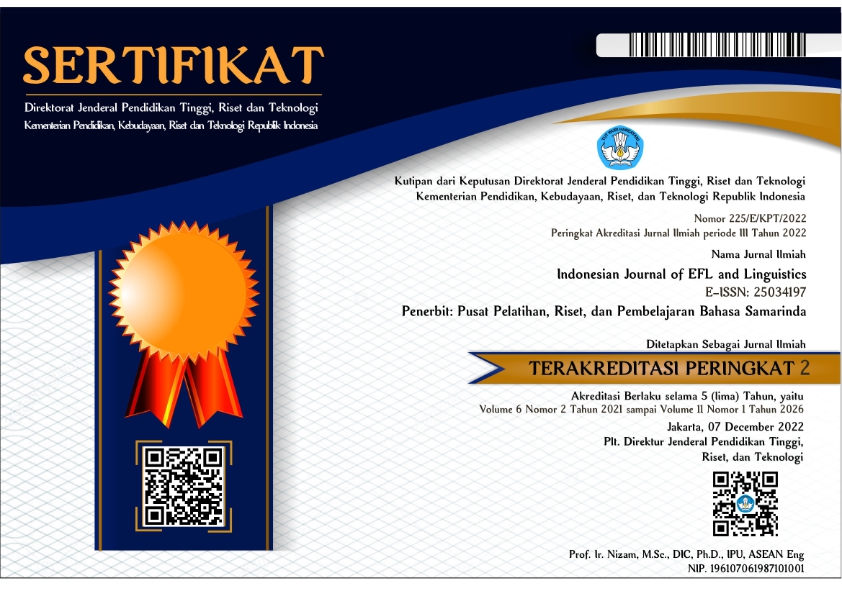Distinctive Features Analysis of Foreign Language Borrowing Words in Javanese Language Found in Panjebar Semangat Magazine
Keywords:
borrowing words, distinctive features, foreign language, generative phonology, Javanese
Abstract
The Javanese language belongs to language which has unique phonological system. There are so many foreign language has influenced the development of Javanese. This study is intended to examine the sound change of borrowing word of foreign language in Javanese which is found in Panjebar Semangat magazine. The data is taken from Panjebar and checked using old Javanese dictionary. This study belongs to descriptive qualitative research and used Simak method and Non Participant Observation in collecting the data. The data analysis is done by using Padan method. The result of the study reveals three sound changes of vowels sound and four phonological rules. Then, there are four types of sound change and four phonological rule of consonant sound. The result showed that the sound change of borrowing word in Javanese is influenced by the differences of phonological system between Javanese and the foreign language.References
Al-Hindawi, D. F. H., & Al-Aadili, N. M. (2018). The Basic Tenets of Generative Phonology. Journal of Education and Practice, 10.
As Samer, M. A. A. S. (2015). Phonetic and Phonological Adaptations of English Loanwords into Iraqi Arabic: A Generative Study. Journal of the College of Arts. University of Basra, 73, 46.
Gonda, J. (1998). Sanskrit in Indonesia (Repr). New Delhi: Internat. Acad. of Indian Culture.
Hall, T. A. (Ed.). (2001). Distinctive feature theory. Berlin ; New York: Mouton de Gruyter.
Indrawati, D. (2015). Proses Fonologis Dalam Pengadopsian Kata Bahasa Indonesia Ke Dalam Bahasa Cia-Cia di Kabupaten Buton, Sulawesi Tenggara. Jurnal Pena Indonesia, 1(1), 96. https://doi.org/10.26740/jpi.v1n1.p96-104
Jones, R., Indonesian Etymological Project, KITLV Office Jakarta, & Yayasan Obor Indonesia (Eds.). (2008). Loan-words in Indonesian and Malay. Jakarta: KITLV-Jakarta : Yayasan Obor Indonesia.
Kenstowicz, M. J., & Kisseberth, C. W. (1979). Generative phonology: Description and theory. New York: Academic Press.
Nafisah, S. (2017). Proses Fonologis dan Pengkaidahannya dalam Kajian Fonologi Generatif. DEIKSIS, 9(01), 70. https://doi.org/10.30998/deiksis.v9i01.940
Obied, I. M. (2015). Phonological Rules. https://doi.org/10.13140/rg.2.1.2516.7448
Perwira, Y. K. (2016). Proses Penyerapan Bahasa Belanda ke dalam Bahasa Jawa ( Sebuah Kajian Fonologi Generatif Transformational) (Thesis). Diponegoro University, Semarang.
Putradi, A. W. A. (2016). Pola-Pola Perubahan Fonem Vokal dan Konsonan dalam Penyerapan Kata-Kata Asing Ke Dalam Bahasa Indonesia: Kajian Fonologi. Arbitrer Journal, 3(2), 96–112.
Putu, A. A., Nyoman Seri, N. L., & Suparwa, I. N. (2015). Adaptasi Kosakata Bahasa Bali Dalam Bahasa Melayu Loloan Bali. LITERA, 14(1). https://doi.org/10.21831/ltr.v14i1.4404
Salem Alqahtani, M. (2018). Phonological Adaptation of Arabic Loanwords in Sabzevari Persian: Metathesis and Vowel Epenthesis. Linguistics and Literature Studies, 6(4), 188–195. https://doi.org/10.13189/lls.2018.060405
Schane, S. A. (1973). Generative phonology. Englewood Cliffs, N.J: Prentice-Hall.
Sudaryanto. (1993). Metode dan aneka teknik analisis bahasa: Pengantar penelitian wahana kebudayaan secara linguistis. Yogyakarta: Duta Wacana University Press.
Sutarsih, S. (2017). Penanda Fonologi Bahasa Jawa Dalam Tuturan Masyarakat Tionghoa di Gang Baru Semarang. Aksara, 29(1), 89. https://doi.org/10.29255/aksara.v29i1.103.89-102
Zen, A. L. (2016). Perubahan Fonologis Kosakata Serapan Sansekerta Dalam Bahasa Jawa (Analisis Fitur Distingtif Dalam Fonologi Transformasi Generative) (Thesis, Diponegoro University). Retrieved from http://eprints.undip.ac.id/48453/
As Samer, M. A. A. S. (2015). Phonetic and Phonological Adaptations of English Loanwords into Iraqi Arabic: A Generative Study. Journal of the College of Arts. University of Basra, 73, 46.
Gonda, J. (1998). Sanskrit in Indonesia (Repr). New Delhi: Internat. Acad. of Indian Culture.
Hall, T. A. (Ed.). (2001). Distinctive feature theory. Berlin ; New York: Mouton de Gruyter.
Indrawati, D. (2015). Proses Fonologis Dalam Pengadopsian Kata Bahasa Indonesia Ke Dalam Bahasa Cia-Cia di Kabupaten Buton, Sulawesi Tenggara. Jurnal Pena Indonesia, 1(1), 96. https://doi.org/10.26740/jpi.v1n1.p96-104
Jones, R., Indonesian Etymological Project, KITLV Office Jakarta, & Yayasan Obor Indonesia (Eds.). (2008). Loan-words in Indonesian and Malay. Jakarta: KITLV-Jakarta : Yayasan Obor Indonesia.
Kenstowicz, M. J., & Kisseberth, C. W. (1979). Generative phonology: Description and theory. New York: Academic Press.
Nafisah, S. (2017). Proses Fonologis dan Pengkaidahannya dalam Kajian Fonologi Generatif. DEIKSIS, 9(01), 70. https://doi.org/10.30998/deiksis.v9i01.940
Obied, I. M. (2015). Phonological Rules. https://doi.org/10.13140/rg.2.1.2516.7448
Perwira, Y. K. (2016). Proses Penyerapan Bahasa Belanda ke dalam Bahasa Jawa ( Sebuah Kajian Fonologi Generatif Transformational) (Thesis). Diponegoro University, Semarang.
Putradi, A. W. A. (2016). Pola-Pola Perubahan Fonem Vokal dan Konsonan dalam Penyerapan Kata-Kata Asing Ke Dalam Bahasa Indonesia: Kajian Fonologi. Arbitrer Journal, 3(2), 96–112.
Putu, A. A., Nyoman Seri, N. L., & Suparwa, I. N. (2015). Adaptasi Kosakata Bahasa Bali Dalam Bahasa Melayu Loloan Bali. LITERA, 14(1). https://doi.org/10.21831/ltr.v14i1.4404
Salem Alqahtani, M. (2018). Phonological Adaptation of Arabic Loanwords in Sabzevari Persian: Metathesis and Vowel Epenthesis. Linguistics and Literature Studies, 6(4), 188–195. https://doi.org/10.13189/lls.2018.060405
Schane, S. A. (1973). Generative phonology. Englewood Cliffs, N.J: Prentice-Hall.
Sudaryanto. (1993). Metode dan aneka teknik analisis bahasa: Pengantar penelitian wahana kebudayaan secara linguistis. Yogyakarta: Duta Wacana University Press.
Sutarsih, S. (2017). Penanda Fonologi Bahasa Jawa Dalam Tuturan Masyarakat Tionghoa di Gang Baru Semarang. Aksara, 29(1), 89. https://doi.org/10.29255/aksara.v29i1.103.89-102
Zen, A. L. (2016). Perubahan Fonologis Kosakata Serapan Sansekerta Dalam Bahasa Jawa (Analisis Fitur Distingtif Dalam Fonologi Transformasi Generative) (Thesis, Diponegoro University). Retrieved from http://eprints.undip.ac.id/48453/
Published
2019-11-15
How to Cite
Aprillianti, L. (2019). Distinctive Features Analysis of Foreign Language Borrowing Words in Javanese Language Found in Panjebar Semangat Magazine. Indonesian Journal of EFL and Linguistics, 4(2), 109-120. https://doi.org/10.21462/ijefl.v4i2.130
Section
Articles




